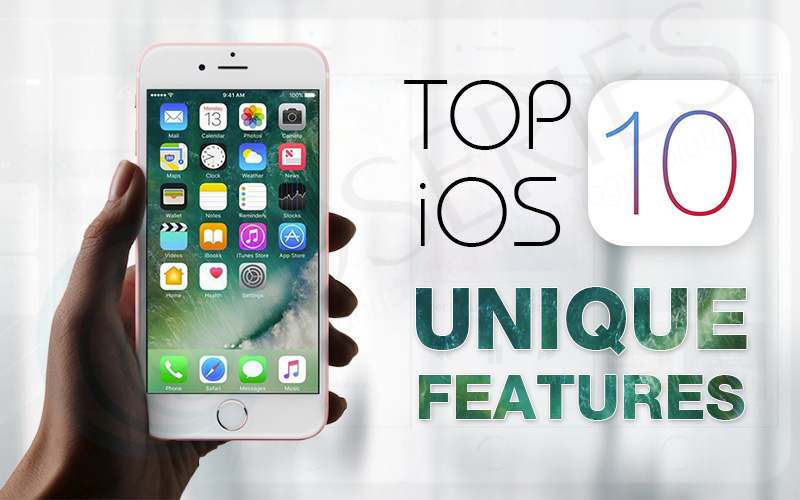Top iOS 10 Unique Features
Hey, now it’s the end time to brainstorm and guess about what will be there in iOS 10 and time to relish for new iOS 10 release. Apple has released its new iOS 10 which unveiled a lot of enhancements in iOS with new APIs with unique designs and interface.
Apple has officially disclosed its all-new iOS 10 for its mobile devices, with backing for a huge number of iPad, iPhone and iPod touch devices. For users who have yet to install the latest operating system, here’s a breakdown of its new features and enhanced implementations.
Apple is calling iOS 10 its “biggest release ever” and this is not at all shocking, given the significant updates it provides for the Mobile Apps interface and various apps and features like Messages, Maps, Apple Music, Photos, Siri and Apple Pay. It even has support for various third-party apps.
Everything you love is now even far better with iOS 10, Biggest release yet….. incorporates new APIs and services that enable new categories of apps and features.
Here are few things iOS Developer can do with iOS 10 that they couldn’t do before.
SiriKit
Apps that provide services in particular domains can use SiriKit to make those services available from Siri for iPhone app developers and development companies. Making your services accessible requires creating one or more app extensions using the Intents and Intents UI frameworks. SiriKit supports services in the following domains:
- Audio or video calling
- Messaging
- Sending or receiving payments
- Searching photos
- Booking a ride
- Managing workouts
- Adjusting settings in a CarPlay-enabled vehicle (automotive vendors only)
- Making restaurant reservations (requires additional support from Apple)
Coordinating with the Messages App
In iOS 10, you can create app extensions that communicate with the Messages app and let users send text, media files, stickers and interactive messages. You can also bolster interactive messages that upgrades as each recipient responds to the message. You can build two types of app extensions:
A Sticker pack provides a collection of stickers that users can add to their Messages content.
An iMessage app gives you a chance to introduce a custom user interface within the Messages app, stickers, create a sticker browser, include text and media files within a conversation, create, send, and update interactive messages.
An iMessage app can also assist users to search images that you have on your application’s connected site while they’re in the Messages app.
User Notifications
iOS 10 introduces the User Notifications framework (UserNotifications.framework), which maintains the delivery and handling of local and remote notifications. You utilize the classes of this framework to plan the delivery of local notifications based on particular conditions, such as location or time. Apps and app extensions can use this framework to receive and potentially adjust remote and local notifications when they are delivered to the user’s device.
Also presented in iOS 10, the User Notifications UI framework (UserNotificationsUI.framework) allows you customize the appearance of remote and local notifications when they appear on the user’s device. You use this framework to determine an app extension that receives the notification data and provides the corresponding visual illustration. Your extension can also respond to custom activities connected with those notifications.
Speech Recognition
iOS 10 introduces a unique API that supports continuous speech recognition and helps you develop apps that can recognize speech and transcribe it into text. Adopting the APIs in the Speech framework (Speech.framework), you can achieve speech transcription of both constant and recorded audio. For instance, you can get a speech recognizer and start simple speech recognition using code like this:
Widget Enhancements
iOS 10 introduces a unique design for the lock screen, which now represents widgets. To ensure that your widget looks great on any background, you can define widgetPrimaryVibrancyEffect or widgetSecondaryVibrancyEffect, as relevant (use these properties rather than the deprecated notificationCenterVibrancyEffect property). In addition, widgets now incorporate the concept of display mode (represented by NCWidgetDisplayMode), which gives you a chance to portray the amount of content is accessible and allows users to prefer a compact or expanded view.
CallKit
The CallKit framework (CallKit.framework) allows VoIP apps incorporate with the iPhone UI and give users a great experience. Use this framework to engage users in viewing and answering incoming VoIP calls on the lock screen and manage contacts from VoIP calls in the Phone app’s Favorites and Recent views.
CallKit also presents app extensions that allow call blocking and caller identification. You can build an app extension that can correlate a phone number with a name or tell the system when a number should be blocked.
HomeKit
In iOS 10, iPad can be configured to grant remote access to accessories, run automation triggers, and facilitate shared user consents. In addition, the HomeKit framework (HomeKit.framework) includes support for camera and doorbell accessories and introduces numerous new APIs that help you:
- View and communicate with IP camera accessory profiles, display snapshots, and live streams and control a camera’s settings, speaker, and microphone
- Access new services and characteristics
- For the primary service, link services and legitimate qualities to provide more connection and configuration about the accessories
- You can also combine and set up accessories using the Apple accessory setup workflow. To learn more, see HomeKit Framework Reference.
These new hooks are slowly but surely redefining the App Store. In short, iOS 10 does bring new features for iPhone developers. Well, it’s time you may want to upgrade your iOS applications.
Recent Posts
Deep Learning Explained: Understanding the Brain Behind AI
The Intersection of AI and IoT: Creating Smarter, Connected Environments
The Evolution of AI: From Simple Algorithms to Neural Networks
The Role of AI in Sustainable Development
Scaling New Heights: Integrating Advanced Technologies in Startup Product Engineering
